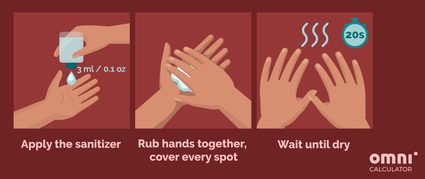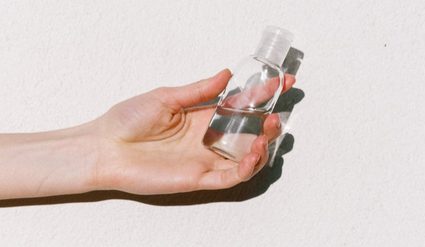Hand Sanitizer Calculator - Coronavirus
The time has finally come - we're slowly going back to normal. It won't be exactly the same however - this new normal needs a few adjustments to make everyone feel safe again. We can't walk around in masks forever, social distancing has its limits (especially in a crowded subway at 7:30 AM), water and soap are not easily accessible all the time. To make things even worse, we constantly touch our faces and objects in public areas, transferring germs to places they shouldn't be.
So what exactly can we do to increase our safety?
➡️ Let's talk about hand sanitizers!
According to a by the Centers for Disease Control (CDC), most people don't use hand sanitizer properly. We decided to create this calculator so you'll always know the exact amount of hand sanitizer you need to keep you protected at all times.🧴
Why hand sanitizers?
Hand sanitizer is a quick and efficient way to keep your hands clean no matter where you are. We all know that the best way to keep them germ free is to wash your hands regularly with soap and water - but hey, they're not everywhere! 🧼
recommends using a hand sanitizer that has an alcohol content of at least 60%. When used correctly, it'll kill most of the germs (including the coronavirus), and protect you and those around you.
Talking about germs... Would you like to know how fast they may spread? Compute it with the bacteria growth calculator!
How much hand sanitizer do I need?
You don't have to overbuy anymore - we'll help you calculate the precise volume and number of bottles your family needs. Follow the steps below:
-
First important decision:
- Are you trying to find how much of hand sanitizer you need to buy?
- Or do you want to check how long your supplies will last for?
-
Choose the number of people in your household - exclude all the babies until the age of 2 (their skin shouldn't get into contact with products containing alcohol).
-
Enter the number of days you want to stay protected for.
-
Think about how much time you and your family spend outdoors. 😷
- Are you self-isolating, and you don't leave your house at all?
- Are you going out a few times a week, just to handle important issues?
- Do you need to leave the house every day?
-
How often do you use your hand sanitizer? All the time? Only when it's absolutely necessary? Choose between small, moderate and extreme usage.
-
Choose your bottle size. We enumerated all the sizes available in the US:
- 1 fl oz/ 29.6 ml
- 2 fl oz/ 59 ml - the typical, portable small bottle, being the most popular size.
- 4 fl oz/ 118 ml
- 8 fl oz/ 237 ml
- 12 fl oz/ 355 ml
- 20 fl oz/ 591 ml
- 68 fl oz/ 2 liters - the biggest size, the best option if you're looking to save money.
-
Your results are ready! We'll also show you how easy it is to care about our planet while shopping. 🌎
When should I use it?
To ensure the maximum level of protection, you should use your hand sanitizer every time you enter or leave a room or a vehicle, or touching someone who's not a part of your household.
🙋♀️Why do we have to use it so often?
An average human touches their face around 3 times per hour. (Some studies estimate that this number may be as large as 27!)
❌ You shouldn't use hand sanitizer in following situations:
- When your hands are visibly dirty;
- When your hands are greasy;
- After leaving the toilet;
- After having contact with people infected with certain bacteria.
How should we use it?
Hand sanitizer only works well if it's used properly.
-
Use at least 3 ml/ 0.1 oz of hand sanitizer - that's more than half of a regular teaspoon (you may use the grams to teaspoons calculator for any necessary estimations).
-
Rub it gently onto both sides of your hands, making sure you cover every spot. The CDC recommends to rub it for at least 30 seconds. How long is it? Enough to sing the song "Happy Birthday" three times!
-
Do not wipe your hands - let them dry on their own!

➕ Always remember to moisturize your hands frequently!
We may not like cracked skin, but bacteria absolutely adores it. 🦠
DIY hand sanitizer
Are you a DIY fan, or do you just want to save a few bucks? This recipe is just for you - as you can see, your health is literally in your hands!

Ingredients:
- Aloe gel.
- Isopropyl alcohol, concentration of 99.8%.
- Tea oil, oregano oil, lavender oil (or any other oil with antiviral/antimicrobial properties).
Method:
- Fill 3/4 of the bottle of the desired size with isopropyl alcohol.
- Add a few drops of every oil you want to use.
- Top up with aloe gel.
Don't forget to use reusable bottles! It doesn't take much to be a hero. 🌎
Ps. Don't know how to count the alcohol concentration in mixtures? Try the alcohol dilution calculator to find the easiest answers!